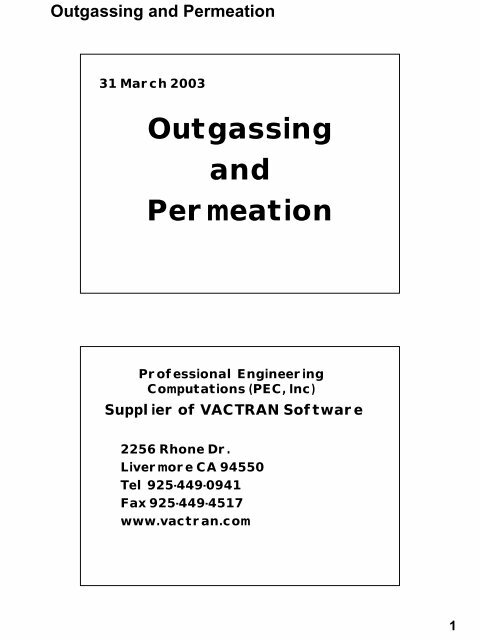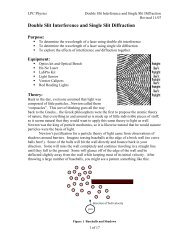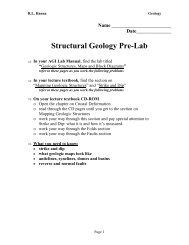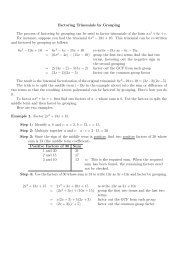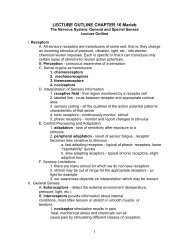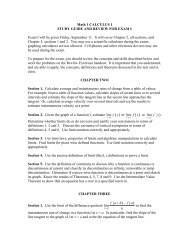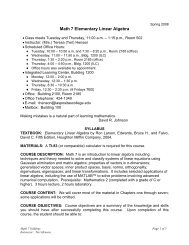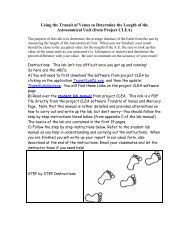Outgassing and Permeation
Outgassing and Permeation
Outgassing and Permeation
- No tags were found...
Create successful ePaper yourself
Turn your PDF publications into a flip-book with our unique Google optimized e-Paper software.
<strong>Outgassing</strong> <strong>and</strong> <strong>Permeation</strong>31 March 2003<strong>Outgassing</strong><strong>and</strong><strong>Permeation</strong>Professional EngineeringComputations (PEC, Inc)Supplier of VACTRAN Software2256 Rhone Dr.Livermore CA 94550Tel 925-449-0941Fax 925-449-4517www.vactran.com1
<strong>Outgassing</strong> <strong>and</strong> <strong>Permeation</strong><strong>Permeation</strong> occurs when there is apressure difference created acrossthe wall of a vacuum vessel thatresults in a net transport ofmoleculesLow pressureHigh pressureThe transport mechanism is pressuredrivendiffusion…d [cm]Low pressureHigh pressure2
<strong>Outgassing</strong> <strong>and</strong> <strong>Permeation</strong>Molecules then desorb from the insidesurface of the vessel <strong>and</strong> participatein the net gas loadLow pressureHigh pressure<strong>Permeation</strong> Happens!Helium Party BalloonsLatex versus Mylar BalloonsAutomobile TiresHydrogen PurificationCalibrated Leaks3
<strong>Outgassing</strong> <strong>and</strong> <strong>Permeation</strong>Model of a Semi-infinite solid withvolatile impuritiesSources of <strong>Outgassing</strong>! General! Adsorbed Water <strong>and</strong> other gases! Metal surfaces! Bulk Impurity diffusion! Surface Impurities! Crystal boundaries! Nonmetal surfaces! Base material volatilization! Thermal <strong>and</strong> Radiation Damage! Search engine:http://outgassing.nasa.gov4
<strong>Outgassing</strong> <strong>and</strong> <strong>Permeation</strong>Beware: <strong>Outgassing</strong> <strong>and</strong> <strong>Permeation</strong> areoften merged in casual vacuum discussionsThe devil is in the details!virtual leaksreal leaks<strong>Permeation</strong>Semi-infinite De-VolatilizationThermal decompositionSurface gas desorbtion.Effects on Ultimate BasePressure! <strong>Outgassing</strong> <strong>and</strong> permeation from o-rings often constrain the ultimatebase pressure of a vacuum system.! The outgassing rate of an o-ring canbe reduced by baking or time.! The permeation rate of an o-ringusually remains constant, but issteeply temperature dependent.5
<strong>Outgassing</strong> <strong>and</strong> <strong>Permeation</strong>Elastomers for Vacuum! Viton has best mechanicalproperties, bakeability (to 180C),with low permeation <strong>and</strong> lowvolatility.! Buna N (Nitrile) lower cost thanviton with same benefits exceptpoorer bakeout resistance.Post-Curing Elastomer O-rings! Manufacturers of Viton o-ringsdon’t know where there productis going.! If base pressure is an issue, postcure in air oven at 140C for 48h,or purchase from vendor postcured.! Vendor: www.uccomponents.com6
<strong>Outgassing</strong> <strong>and</strong> <strong>Permeation</strong>Alternative Elastomers! FFKM materials (Kalrez 8575,Chemraz 630) are expensive,chemistry resistant but havehigher permeation rates thanViton! MFQ materials often have selectchemical resistance, but highpermeation rates.<strong>Outgassing</strong> <strong>and</strong> surfaceroughnessA high quality surface finish is oftenequated with a low outgassing rate.Effective surface area is reducedwhen high quality surface finishesare employed, but this influence isnot profound.Surface finish usually does not drivefabrication costs in small vessels,but frequently does in large.7
<strong>Outgassing</strong> <strong>and</strong> <strong>Permeation</strong>Surfaces for Vacuum service may needattention of the following issues! Alloy specification! Cutting fluids! Machine tooling! Post-machine cleaning! Surface protection <strong>and</strong>packagingThe goal is low base pressure! Often the purpose of a smoothersurface is cleanability orinspectability.! Machining of vacuumcomponents is best accompshedwith a sharp, single point tool.! Cutting fluids should notcontain sulfur based lubricants.8
<strong>Outgassing</strong> <strong>and</strong> <strong>Permeation</strong><strong>Outgassing</strong>rates forCommonVacuummaterialsCourtesy LLNL<strong>Outgassing</strong> Data alternatively given inform of 4 coefficients(3600 / 1 1 )a 1Q< = Q tQhour1− 10hours=Q (3600 / t)1(logQQ (3600 /> 10= Q10 t)hours[ Q Q a ], a1 10, 1, 10a110−logQ10)9
<strong>Outgassing</strong> <strong>and</strong> <strong>Permeation</strong>Example of <strong>Outgassing</strong> Data (CourtesyPEC)Condition A1 A10 Q1 Q10Aluminum (fresh) 1.0 1.0 6.300E-09 6.000E-10Aluminum (degassed 24-h) 3.2 0.9 4.140E-09 3.060E-10Aluminum (3-h in air) 1.9 0.9 6.645E-09 4.747E-10Aluminum (anodized) 0.9 0.9 2.759E-07 3.217E-08Aluminum (baked 15h @250C) 0.0 0.0 3.975E-13 3.975E-13Aluminum (baked 20h @ 100C) 0.0 0.0 3.975E-14 3.975E-14<strong>Outgassing</strong>.xls (downloadable)<strong>Outgassing</strong> of Common Vacuum Construction Materials1.00E-02Silicone Aluminum, 3h in Air Al Baked 20h at 200C 304 SS Baked 30h @ 250CViton Viton, 12h @ 200C Pyrex, 1 month in Air Anodized Aluminum1.00E-031.00E-04torr-liters/second/sq-cm1.00E-051.00E-061.00E-071.00E-081.00E-091.00E-101.00E-111.00E-121.00E-131.0E+01 1.0E+02 1.0E+03 1.0E+04 1.0E+05 1.0E+06 1.0E+07Time, Seconds10
<strong>Outgassing</strong> <strong>and</strong> <strong>Permeation</strong><strong>Permeation</strong> for a given material <strong>and</strong>gas isProportional to! Pressure differential (usually 1 atm)! Effective Area! Partial Pressure of Gas SpeciesInversely Proportional to! ThicknessLike outgassing, it is another source.<strong>Permeation</strong> is gas-species sensitive! Identify the materials constituting the vacuumvessel walls! Identify the permeation gas of interest (e.g., N 2 , O 2 ,H 2 0, Tritium)! Estimate the permeation surface area <strong>and</strong>thickness! Apply Daltons Laws of Partial Pressure (ifapplicable)! Look up the permeation rate for each material<strong>and</strong> gas! Calculate the permeation gas load for eachmaterial! Sum them for the total permeation gas load11
<strong>Outgassing</strong> <strong>and</strong> <strong>Permeation</strong>QEquation for Calculating thepermeation ratek A( ∆P)= 10 pdQ leak rate, t-liter/seck p permeation, m 2 /secA Area, cm 2∆P Pressure, Torrd Thickness, cmPressure differential is equal to 1atmosphere for many casesLow pressure Atmospheric pressure= 0.76 Torr = 760 Torr= 101 Pa= 101,000 Pa∆P = (P Atm − P vac )∆P = (760− 0.76) = 759.24 Torr∆P = (101,000−101) =100,899 Pa12
<strong>Outgassing</strong> <strong>and</strong> <strong>Permeation</strong>Useful Unit Conversions for<strong>Permeation</strong>1333.2 Watts/sq-meter = 1 torrliter/sec/sq-cmA Watt is a unit of energy per time, justlike a torr-liter/sec!<strong>Permeation</strong> data is usually tabulated insquare-meters/sec!<strong>Outgassing</strong> Rates are influencedby surface preparationCourtesy Howard Patton13
<strong>Outgassing</strong> <strong>and</strong> <strong>Permeation</strong><strong>Permeation</strong> data is dependent on:gas-species presentmaterialhistorytemperatureMaterial sq-cm/sec sq-meter/secBuna-N (high value for CO2) 4.80E-07 4.80E-11Buna-N (High value for Helium) 6.00E-08 6.00E-12Buna-N (High value for Nitrogen) 2.00E-08 2.00E-12Buna-N (high value for Oxygen) 6.00E-08 6.00E-12Buna-N (low value for CO2) 5.70E-08 5.70E-12Buna-N (low value for Helium) 5.20E-08 5.20E-12Buna-N (low value for Nitrogen) 2.00E-09 2.00E-13Buna-N (low value for Oxygen) 7.00E-09 7.00E-13Buna-N (water) 7.60E-06 7.60E-10<strong>Permeation</strong> is geometry DependentO-ring is most common featureConservativeAssumptions<strong>Permeation</strong> Area ist x Length of O-ringt<strong>Permeation</strong> thickness is1/2 t14
<strong>Outgassing</strong> <strong>and</strong> <strong>Permeation</strong>Calculating the permeation distance(half the o-ring thickness)dt 0.125"= = =2 20.063"0.063" × 2.54 cm / in = 0.16cmCalculate the AREA of the O-ring thegas is permeating through forthickness t <strong>and</strong> Diameter D:15
<strong>Outgassing</strong> <strong>and</strong> <strong>Permeation</strong>Calculating the AREA of a circular O-ringA= πDtD is the inside diametert is the thicknessWarning: Units Trap!39.37 inches per meter2.54 cm per inchWays to reduce <strong>Permeation</strong>! Use metal seals whereeconomically feasible.! Use a pair of o-rings <strong>and</strong>differentially pump the trappedvolume.! Example: UHV Monochromator sealdetail.! Deploy low permeability gases<strong>and</strong> materials where possible! Be wary of water in particular.It has a high permeation rate16


